Your smartphone’s already equipped with several motion sensors that you’re probably using without realizing it. The accelerometer, gyroscope, and magnetometer work behind the scenes for everything from screen rotation to fitness tracking. But you can also connect external motion detectors through Bluetooth or Wi-Fi to create a thorough monitoring system. The real question isn’t whether these sensors work with your phone—it’s how you’ll configure them to maximize their potential.
Types of Motion Sensors Compatible With Smartphones
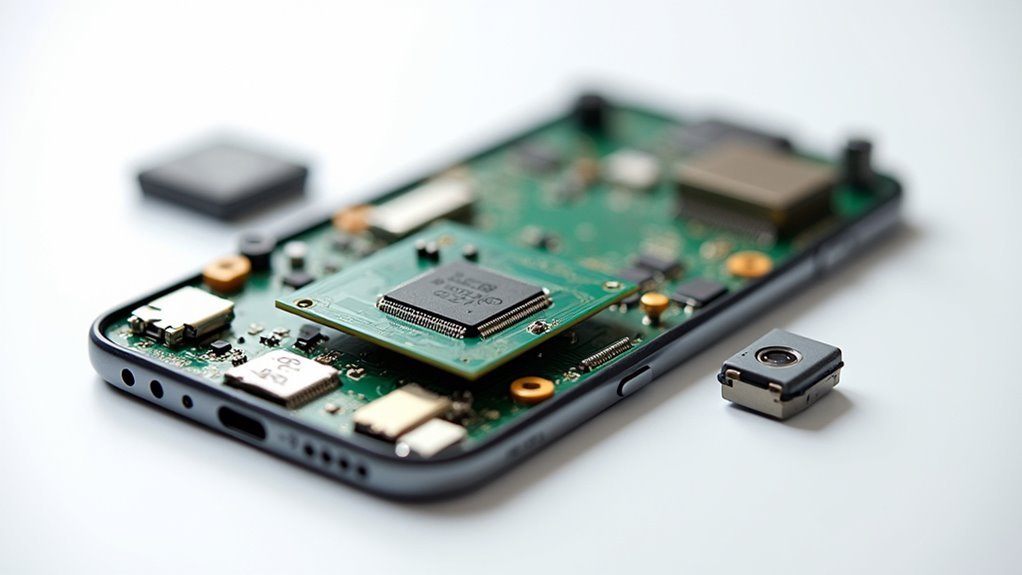
When you pick up your smartphone, you’re holding a device packed with sophisticated motion sensors that constantly monitor movement and orientation.
Your phone contains five primary types of motion sensors.
Accelerometers measure acceleration forces along three axes, enabling screen rotation and fitness tracking.
Gravity sensors detect gravitational force to determine device orientation and work alongside accelerometers.
Gyroscopes measure rotation rates around all axes, providing essential data for augmented reality and motion stabilization.
Linear acceleration sensors track movement while excluding gravity’s influence, perfect for precise applications like vehicle speed measurement.
Finally, rotation vector sensors offer compact orientation representation for gesture detection.
Each motion detector serves specific functions that enhance your smartphone’s capabilities and user experience.
Built-in Accelerometer and Gyroscope Capabilities
While your smartphone contains multiple motion sensors, the accelerometer and gyroscope form the core foundation for all movement detection. Your acceleration sensor measures force along three axes, delivering data in meters per second squared to track how fast you’re moving or changing direction.
Meanwhile, your gyroscope captures rotational movement in radians per second, detecting when you tilt, turn, or rotate your device. Together, these sensors sample data 200-400 times per second, ensuring they catch even rapid movements with precision.
This combination enables your phone’s gaming controls, augmented reality features, and fitness tracking capabilities. Your device also creates software-based sensors like gravity and linear acceleration by processing this raw accelerometer and gyroscope data for enhanced functionality.
Wireless PIR Motion Detectors for Smart Home Integration
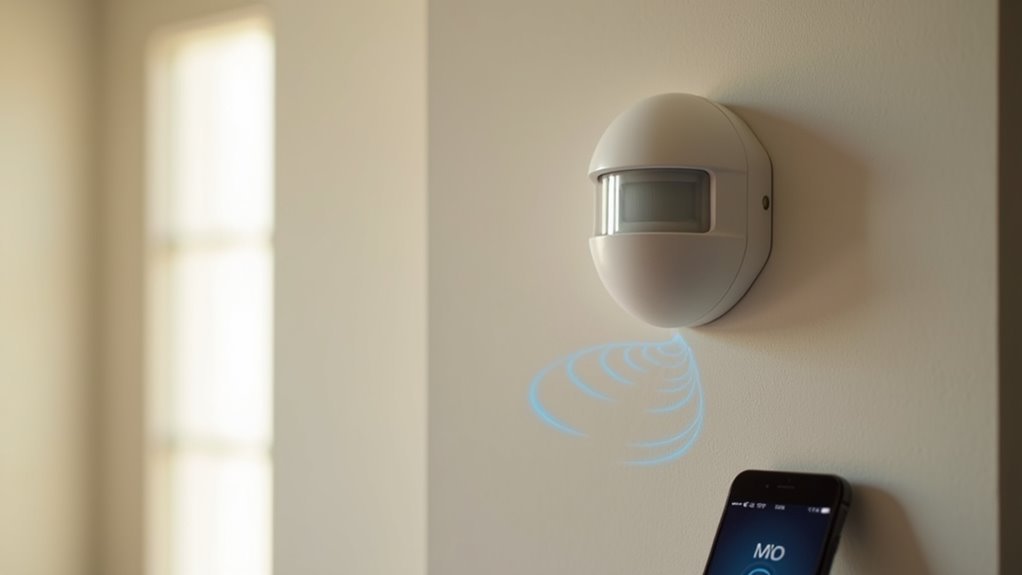
You’ll need a stable Wi-Fi connection to link wireless PIR motion detectors with your smartphone and smart home ecosystem.
These sensors connect through popular apps like Tuya or Smart Life, enabling you to receive real-time motion alerts directly on your phone.
Your home’s wireless network becomes the bridge that transforms standalone motion detectors into integrated smart security components you can monitor remotely.
Wi-Fi Connectivity Requirements
Before you can harness the full potential of wireless PIR motion detectors in your smart home setup, you’ll need to assure your Wi-Fi network operates on the 2.4GHz frequency band.
This specific frequency requirement assures stable communication between your motion detectors and smartphone apps like Tuya and Smart Life.
Most modern routers broadcast on both 2.4GHz and 5GHz bands, but these sensors exclusively connect to 2.4GHz networks.
This frequency provides better range and wall penetration, making it ideal for home security applications.
- Never miss a break-in with instant motion alerts sent directly to your phone
- Sleep peacefully knowing your family’s protected around the clock
- Catch package thieves before they escape with your deliveries
- Monitor elderly relatives’ daily activity for peace of mind
- Receive low battery warnings preventing security gaps
Smart Home Integration
Once your wireless PIR motion detector connects to your 2.4GHz network, it becomes a powerful automation hub that transforms how your smart home responds to movement.
Through platforms like Tuya or Smart Life, you’ll achieve seamless smart home integration with your existing devices. Your sensor detects movement within 10 meters at a 128° angle, triggering automated responses from lights, door sensors, and other connected devices.
You can customize alerts for motion detection, absence of movement, and low battery warnings. This creates interactive environments where your home responds intelligently to activity.
Installation is straightforward with flat placement or wall mounting options. While battery-powered models may respond slightly slower due to energy-saving features, they still provide reliable real-time monitoring for enhanced security automation.
Bluetooth-Enabled Motion Sensors for Real-Time Monitoring
Bluetooth-enabled motion sensors revolutionize how you monitor and analyze movement in real-time.
These cutting-edge wireless sensors transform movement analysis, delivering precise real-time data directly to your mobile device with unprecedented convenience.
These sophisticated devices connect seamlessly to your mobile phone via Bluetooth®, transforming how you collect and analyze motion data. With Vernier Graphical Analysis and similar apps, you’ll track position, velocity, and acceleration with remarkable precision.
The Go Direct Motion Detector exemplifies this technology, offering 1mm resolution across a 15cm to 3.5m range.
You’ll appreciate the wireless operation powered by rechargeable batteries, making these sensors incredibly portable for various environments.
Benefits that’ll transform your experience:
- Instant data visualization on your phone screen
- Freedom from tangled wires during experiments
- Professional-grade accuracy in your hands
- Versatile applications from classroom to field research
- Enhanced learning through interactive real-time feedback
Wi-Fi Motion Sensors With App Control Features
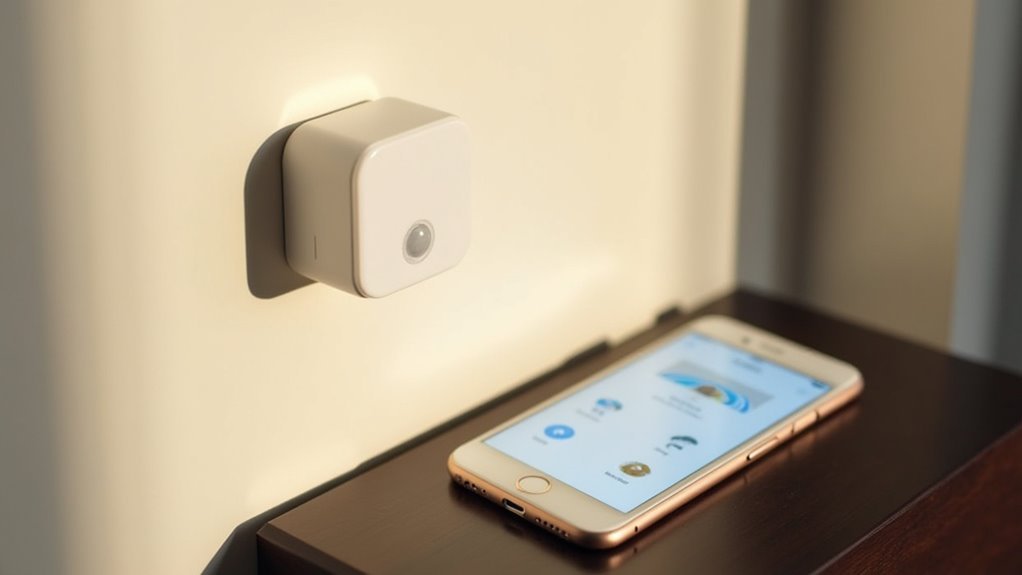
You’ll find setting up Wi-Fi motion sensors with your smartphone incredibly straightforward through apps like Tuya or Smart Life.
These apps let you receive instant alerts, customize notification preferences for motion detection and low battery warnings, and review your motion history from anywhere.
Once you’ve got the basic app integration working, you can expand functionality by linking your motion sensors with other smart home devices like lights and door sensors to create automated scenes.
App Integration Setup
When you’re ready to harness the full potential of Wi-Fi motion sensors, integrating them with mobile applications like Tuya or Smart Life transforms your smartphone into an all-encompassing home security command center.
The app integration process connects your sensor seamlessly to create automated scenes with compatible devices like lights and door sensors.
You’ll receive real-time alerts and access thorough motion history tracking, keeping you informed about every movement in your monitored areas.
The setup enables customizable notifications for various scenarios, ensuring you’re always connected to your home’s security status.
- Never miss a moment – Real-time alerts keep you instantly informed
- Peace of mind anywhere – Monitor your home from any location
- Complete control – Manage everything from one smartphone app
- Smart automation – Create scenes that respond to your lifestyle
- Stay connected – Receive notifications wherever you have internet
Smart Home Linkage
Smart home linkage elevates your Wi-Fi motion sensors beyond simple detection by creating an interconnected ecosystem that responds intelligently to your daily routines.
When you connect motion sensors through Tuya-compatible platforms, you’ll reveal automated responses that transform how your home operates. Your sensor can trigger lights to illuminate hallways when movement occurs, activate security cameras for enhanced monitoring, or sound alarms during unauthorized entry attempts.
The integration extends beyond basic automation. You’ll receive customized notifications for various scenarios, including motion detection, periods of inactivity, and low battery warnings.
This all-encompassing approach guarantees you’re always informed about your home’s status. The flexibility of linking multiple smart devices creates personalized scenes that adapt to your lifestyle, making your home more responsive and secure.
USB-Connected Motion Detectors for Direct Data Transfer
While wireless motion sensors offer convenience, USB-connected motion detectors provide the most reliable data transfer method for your phone and other devices.
These sophisticated instruments, like the Go Direct Motion Detector, deliver precise measurements of position, velocity, and acceleration with remarkable 1mm resolution across a 15cm to 3.5m range.
You’ll appreciate the streamlined setup since USB connectivity eliminates additional software purchases.
With sampling rates reaching 30 samples per second, you can capture detailed motion analysis data directly to your mobile device, Chromebook, or computer through simple USB connection.
Why USB-connected motion detectors transform your research:
- Instant data reliability without wireless interference worries
- Professional-grade accuracy that validates your scientific work
- Cross-platform compatibility freeing you from device limitations
- Zero additional costs beyond the detector itself
- Real-time precision that captures every essential measurement moment
Battery Vs Wired Power Options for External Sensors
When choosing an external motion sensor for your phone, you’ll face a critical decision between battery-powered and wired options.
Battery-powered sensors offer placement flexibility but require monitoring of power levels, with quality units providing extended life through low 38uA drain rates.
USB-powered sensors eliminate battery concerns entirely, delivering consistent performance that’s especially valuable for high-frequency detection scenarios.
Battery Life Considerations
Since external motion sensors offer both battery and wired power options, you’ll need to weigh the trade-offs between convenience and reliability.
Battery life becomes essential when you’re relying on portable power sources like 2 AA batteries. Your sensor’s battery life depends heavily on usage patterns. With minimal activity, you can expect extremely low power consumption at just 38uA, extending operational time considerably.
However, frequent triggering and constant alarm conditions will drain batteries faster than anticipated.
Consider these battery life factors:
- Dead batteries mean zero protection – your security gaps when power dies
- Midnight battery failures leave you vulnerable during critical hours
- Reduced response times frustrate you when sensors lag on battery power
- Constant battery replacements drain your wallet and patience
- USB power eliminates anxiety about unexpected sensor downtime
USB Power Stability
USB power transforms your external motion sensors from battery-dependent devices into reliable, always-on security components. When you’re evaluating usb power stability versus battery options, USB connections deliver consistent performance without worrying about power depletion during critical monitoring periods.
| Power Source | Stability | Maintenance | Best Use Case |
|---|---|---|---|
| USB Cable | Constant power supply | Zero battery replacements | Continuous monitoring |
| Battery | Intermittent reliability | Periodic replacements needed | Temporary setups |
| Rechargeable | Moderate stability | Occasional charging required | Portable applications |
Your detector sensor benefits greatly from USB power’s immediate availability. Smart Wi-Fi Motion Sensors and Go Direct Motion Detectors both support USB connections, eliminating battery drain concerns. You’ll achieve uninterrupted performance for security applications where consistent power matters most, making USB the superior choice for permanent installations.
Installing Motion Sensor Apps on Android and Ios
Although your smartphone already contains built-in motion sensors, you’ll need to download specialized apps to access their full capability for motion detection and monitoring.
For Android users, you’ll find motion sensor apps through the Google Play Store, while iOS users can browse the Apple App Store for compatible applications.
During installation, you’ll need to grant necessary permissions for ideal sensor access. Choose apps with positive ratings and reviews to guarantee reliable performance.
Many motion sensor apps offer additional features like step counting and activity tracking.
- Transform your phone into a powerful security system
- Monitor your daily activities and fitness progress effortlessly
- Detect unauthorized movement in your home or office
- Track your sleep patterns for better health insights
- Experience cutting-edge technology at your fingertips
Pairing External Motion Detectors With Your Device
While smartphone apps access your device’s internal sensors, you can greatly expand your motion detection capabilities by connecting external motion detectors to your phone.
These devices pair via Wi-Fi or Bluetooth, offering enhanced home security and automation features beyond what your phone’s built-in sensor measures.
Popular options include Smart Wi-Fi Motion Sensors that integrate with Tuya or Smart Life apps, sending real-time alerts to your device.
For precision tracking, devices like the Go Direct Motion Detector use ultrasound technology and connect through Bluetooth or USB, detecting objects from 15 cm to 3.5 meters.
When pairing external detectors, verify compatibility with your smartphone’s operating system.
Some sensors require specific permissions like ACTIVITY_RECOGNITION to function properly and accurately track movement data.
Configuring Motion Detection Settings and Sensitivity
You’ll need to fine-tune three critical parameters to optimize your phone’s motion detection performance.
Start by adjusting sensor sampling rates to balance battery life with responsiveness.
Then set detection thresholds that distinguish intentional movements from accidental bumps.
Finally, calibrate filter parameters to eliminate background noise while preserving the motion data you actually want to capture.
Adjusting Sensor Sampling Rates
Since motion sensors continuously collect data from your device’s accelerometer, gyroscope, and magnetometer, adjusting their sampling rates becomes essential for optimizing both performance and battery life.
You’ll typically find sampling rate options ranging from 200 to 400 samples per second for accelerometers. Higher rates deliver more detailed motion tracking but drain your battery faster.
When you increase the sampling rate, you’re getting more responsive motion detection that captures subtle movements with greater precision. However, you’ll need to balance this against power consumption.
Most smartphones let you customize these settings through motion-related apps or system preferences.
- Capture every heartbeat during intense workout sessions with ultra-responsive tracking
- Never miss a step while counting your daily fitness achievements
- Feel confident knowing your phone detects the slightest gestures accurately
- Stay worry-free about battery drain with optimized sampling rates
- Experience seamless motion-based gaming and app interactions
Setting Detection Thresholds
After you’ve refined your sampling rates, configuring detection thresholds becomes your next priority for fine-tuning motion sensor performance.
You’ll find adjustable sensitivity settings in most motion detection apps’ settings menus, allowing you to customize how easily sensors activate based on movement intensity.
Setting higher detection thresholds reduces false positives by requiring more substantial movement to trigger alerts, while lower thresholds increase responsiveness but generate more frequent notifications.
Your accelerometers and gyroscopes can be calibrated through software settings to improve accuracy for specific environments or applications.
You should regularly test and fine-tune these detection thresholds using real-world scenarios. This guarantees ideal performance whether you’re using motion sensors for fitness tracking, home security, or other applications requiring precise movement detection.
Calibrating Filter Parameters
When fine-tuning your motion sensor’s performance, calibrating filter parameters becomes essential for achieving ideal detection accuracy.
You’ll need to implement low-pass filters on accelerometer data to isolate gravity effects while using high-pass filters to eliminate slow-moving signals. This dual approach enhances your app’s responsiveness markedly.
Calibrating filter parameters transforms your motion detection experience:
- Eliminate false alarms – Configure sensitivity settings to distinguish between meaningful movement and random vibrations
- Capture every step – Fine-tune step counters to accurately track your fitness progress without missing beats
- Personalize detection – Set custom thresholds that recognize your unique movement patterns and preferences
- Filter unwanted noise – Remove environmental interference that clutters your motion data
- Enhance gesture control – Achieve precise recognition for seamless device interaction
Setting Up Automated Home Responses to Motion Events
While motion sensors detect movement effectively, their true power emerges when you connect them to automated home responses that react instantly to detected events.
You can create sophisticated workflows using smart home apps like Tuya or Smart Life that trigger multiple actions when motion occurs. Your smartphone’s accelerometers and gyroscopes enable seamless integration with Wi-Fi motion sensors that detect movement up to 10 meters away.
Set up scenarios where motion detection automatically turns on lights, locks doors, adjusts thermostats, or sends security alerts.
Motion-activated automation transforms your home into a responsive environment that anticipates and reacts to your presence instantly.
You’ll want to customize responses based on human versus animal movement to avoid false triggers. Configure notifications for motion events, no-motion periods, and low battery warnings to maintain system reliability and optimize your home’s security and energy efficiency.
Troubleshooting Connection Issues With Motion Sensors
Even the most carefully configured automated home responses won’t function if your motion sensors can’t maintain stable connections with your smartphone.
Connection problems with your motion detector can disrupt your entire smart home ecosystem, leaving you vulnerable and frustrated.
Start with compatibility verification—check your smartphone’s specifications against your detector’s requirements.
Confirm your motion sensor has adequate power through fresh batteries or proper electrical connections.
Navigate to your phone’s Bluetooth settings and confirm pairing status; sometimes reconnecting resolves stubborn issues.
- Your family’s safety depends on reliable motion detection
- Constant reconnection attempts waste precious time
- Failed connections leave your home unprotected
- Technical glitches create unnecessary stress
- Smooth automation brings peace of mind
Update both your operating system and sensor apps regularly, and grant necessary permissions for location and Bluetooth access.
Privacy and Security Considerations for Motion Data
Although motion sensors enhance your smartphone’s functionality, they can inadvertently expose your most private conversations and activities to unauthorized surveillance.
Your phone’s accelerometer, designed to detect acceleration and movement, can capture sound vibrations from nearby conversations. Unlike microphones, these sensors aren’t well-regulated by privacy controls, creating potential security gaps.
Research demonstrates that machine learning algorithms can reconstruct spoken words from accelerometer data, turning motion detection into an unintended listening device.
Rogue applications could exploit your phone’s ability to sense lower-frequency vibrations without your knowledge or consent.
You need awareness of these vulnerabilities to protect yourself.
Check app permissions regularly, limit sensor access for unnecessary applications, and stay informed about privacy updates. Understanding these risks helps you make better decisions about which apps deserve access to your motion data.
Optimizing Motion Sensor Performance and Battery Life
Beyond protecting your motion data, you’ll want to maximize how well these sensors work while preserving your phone’s battery life. Regular software updates improve sensor accuracy and efficiency, ensuring your gravity sensor and other motion detectors perform at their best.
You can greatly reduce power consumption by lowering sampling rates from 200-400 samples per second to just 30 samples per second.
Smart optimization strategies include:
- Calibrate your accelerometer and gyroscope for lightning-fast responsiveness that amazes
- Enable low-power modes in apps to enjoy worry-free, all-day battery performance
- Combine multiple sensor data streams for incredibly accurate activity detection
- Reduce sampling frequency to free up hours of additional battery life
- Update device software regularly to experience cutting-edge sensor improvements
These techniques help you balance performance with power efficiency effectively.
Frequently Asked Questions
Can I Use My Phone as a Motion Detector?
You can use your phone as a motion detector by utilizing its built-in accelerometer and gyroscope sensors. These sensors detect movement and orientation changes, allowing motion detection apps to monitor activity for security or fitness purposes.
Do Smartphones Have Motion Sensors?
Yes, your smartphone’s equipped with multiple motion sensors including accelerometers, gyroscopes, gravity sensors, and linear acceleration sensors. These detect movement, rotation, and orientation changes, enabling features like step counting, screen rotation, and augmented reality experiences.
How to Activate Motion Sensor on Android?
You’ll activate motion sensors by opening Settings, tapping “Connected devices” or “Motion/Gestures,” then enabling desired features like “Lift to wake.” Grant sensor permissions to apps and keep your device updated for peak performance.
What Is the Difference Between Motion Alerts and Motion Detection?
Motion detection is your sensor’s ability to recognize movement within its range, while motion alerts are the notifications you’ll receive when that movement occurs. Detection senses; alerts inform you.

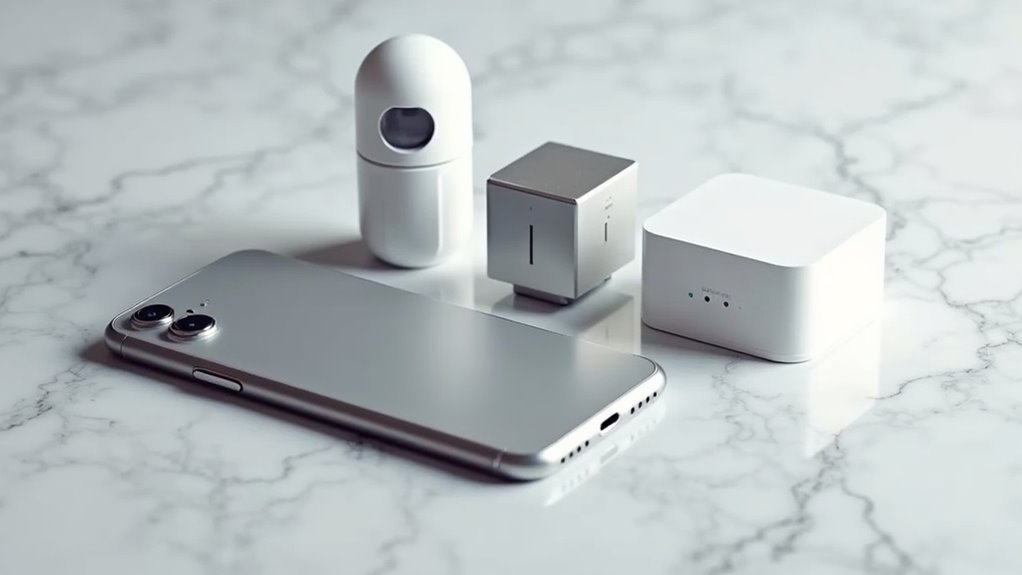
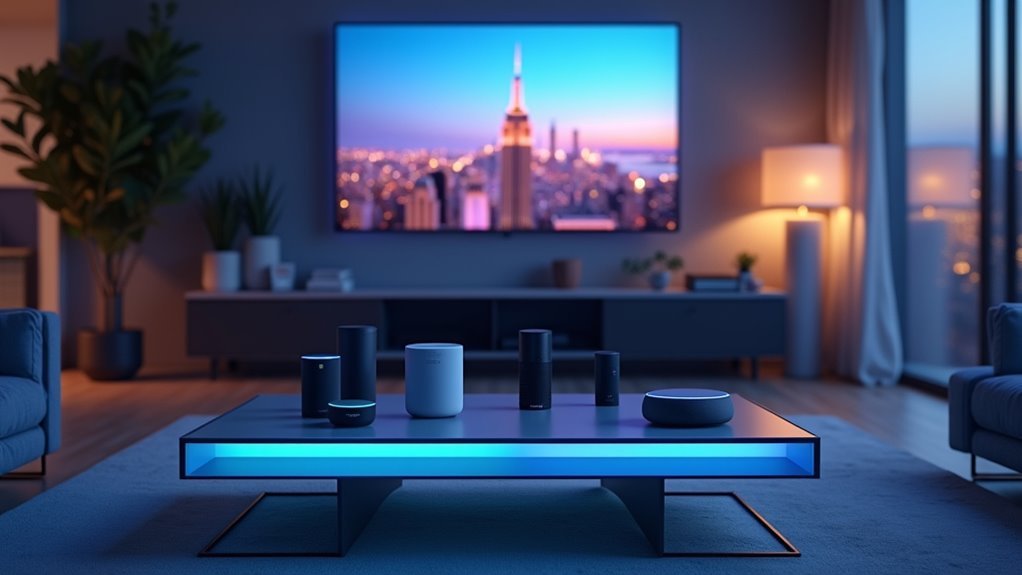
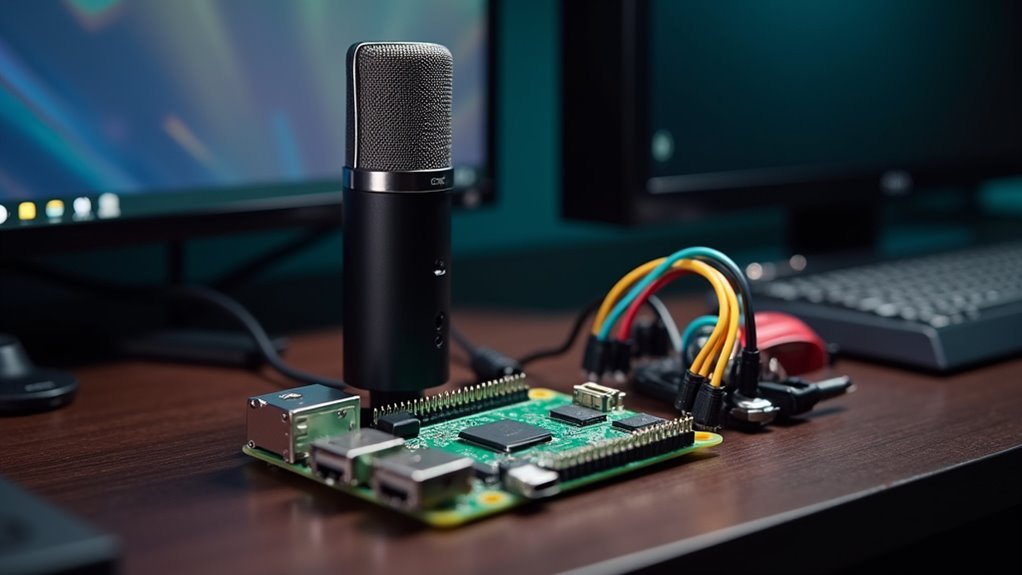

Leave a Reply